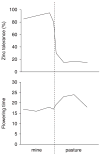The speed of ecological speciation
- PMID: 19096732
- PMCID: PMC2605086
- DOI: 10.1111/j.1365-2435.2006.01240.x
The speed of ecological speciation
Abstract
Adaptation can occur on ecological time-scales (contemporary evolution) and adaptive divergence can cause reproductive isolation (ecological speciation). From the intersection of these two premises follows the prediction that reproductive isolation can evolve on ecological time-scales. We explore this possibility in theory and in nature. Finding few relevant studies, we examine each in some detail. THEORY: Several models have demonstrated that ecological differences can drive the evolution of partial reproductive barriers in dozens to hundreds of generations. Barriers likely to evolve quickly include dispersal rate, habitat preference and selection against migrants/hybrids. PLANTS: Adjacent populations adapting to different fertilizer treatments or to mine tailings can develop reproductive barriers within at least 100 generations. These barriers include differences in flowering time and selection against migrants/hybrids. INVERTEBRATES: Populations on native and introduced host plants can manifest reproductive barriers in dozens to hundreds of generations. These barriers include local host preference and selection against migrants/hybrids. VERTEBRATES: Salmon adapting to divergent breeding environments can show restricted gene flow within at least 14 generations. Birds evolving different migratory routes can mate assortatively within at least 10-20 generations. Hybrid sculpins can become isolated from their ancestral species within at least 20-200 generations. Ecological speciation can commence within dozens of generations. How far it goes is an important question for future research.
Figures



Similar articles
-
Adaptive divergence and the evolution of reproductive isolation in the wild: an empirical demonstration using introduced sockeye salmon.Genetica. 2001;112-113:515-34. Genetica. 2001. PMID: 11838786
-
The consequences of phenotypic plasticity for ecological speciation.J Evol Biol. 2011 Feb;24(2):326-42. doi: 10.1111/j.1420-9101.2010.02169.x. Epub 2010 Nov 19. J Evol Biol. 2011. PMID: 21091567
-
REPRODUCTIVE ISOLATION BETWEEN SYMPATRIC RACES OF PEA APHIDS. I. GENE FLOW RESTRICTION AND HABITAT CHOICE.Evolution. 1999 Oct;53(5):1446-1457. doi: 10.1111/j.1558-5646.1999.tb05409.x. Evolution. 1999. PMID: 28565574
-
Climate adaptation and speciation: particular focus on reproductive barriers in Ficedula flycatchers.Evol Appl. 2015 Jun 30;9(1):119-34. doi: 10.1111/eva.12276. eCollection 2016 Jan. Evol Appl. 2015. PMID: 27087843 Free PMC article. Review.
-
Natural selection and divergence in mate preference during speciation.Genetica. 2007 Mar;129(3):309-27. doi: 10.1007/s10709-006-0013-6. Epub 2006 Aug 10. Genetica. 2007. PMID: 16900317 Review.
Cited by
-
Ecological opportunity and the adaptive diversification of lineages.Ecol Evol. 2015 Jan;5(1):176-95. doi: 10.1002/ece3.1347. Epub 2014 Dec 17. Ecol Evol. 2015. PMID: 25628875 Free PMC article. Review.
-
Mutualistic microalgae co-diversify with reef corals that acquire symbionts during egg development.ISME J. 2021 Nov;15(11):3271-3285. doi: 10.1038/s41396-021-01007-8. Epub 2021 May 19. ISME J. 2021. PMID: 34012104 Free PMC article.
-
Changes in selection pressure can facilitate hybridization during biological invasion in a Cuban lizard.Proc Natl Acad Sci U S A. 2021 Oct 19;118(42):e2108638118. doi: 10.1073/pnas.2108638118. Proc Natl Acad Sci U S A. 2021. PMID: 34654747 Free PMC article.
-
Environmental and molecular analysis of the floral transition in the lower eudicot Aquilegia formosa.Evodevo. 2011 Feb 17;2:4. doi: 10.1186/2041-9139-2-4. Evodevo. 2011. PMID: 21329499 Free PMC article.
-
Ecological opportunity and the evolution of habitat preferences in an arid-zone bird: implications for speciation in a climate-modified landscape.Sci Rep. 2016 Jan 20;6:19613. doi: 10.1038/srep19613. Sci Rep. 2016. PMID: 26787111 Free PMC article.
References
-
- Antonovics J, Bradshaw AD. Evolution in closely adjacent plant populations VIII. Clinal patterns at a mine boundary. Heredity. 1970;25:349–362. - PubMed
-
- Barluenga M, Stolting KN, Salzburger W, Muschick M, Meyer A. Sympatric speciation in Nicaraguan crater lake cichlid fish. Nature. 2006;439:719–723. - PubMed
-
- Bearhop S, Fiedler W, Furness RW, Votier SC, Waldron S, Newton J, Bown GJ, Berthold P, Farnsworth K. Assortative mating as a mechanism for rapid evolution of a migratory divide. Science. 2005;310:502–504. - PubMed
-
- Berthold P, Helbig AJ, Mohr G, Querner U. Rapid evolution of migratory behaviour in a wild bird species. Nature. 1992;360:668–670.
Grants and funding
LinkOut - more resources
Full Text Sources
